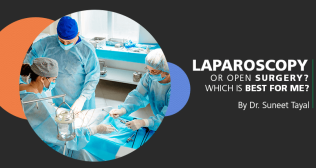
Role of Robot-assisted surgery in Gynaecology
The idea of robotics for surgery began more than 50 years ago, but the actual use began in late 1980 with Robodoc for prosthetic hip replacement. In 1999 Dr Ralph Damiano at Penn State College of Drugs in Hershey performed the first robotic assisted beating heart bypass surgery. In India AIIMS Delhi was the first institute to start robotic-assisted surgery in 2006 for urology cases.
The robotic system consists of 2 consoles. The doctor console is where the doctor sits and visualizes the operating field through a 3D video camera and manipulates the arms that are into the patient and which are a part of the patient console. Both consoles are connected through a computer-generated automatic system.
Various Gynaec surgeries possible with the robotic-assisted system include fibroid removal, uterus removal, cyst removal, prolapse surgery, and complex surgeries like endometriosis and uterine cancer.
The advantage of robotic-assisted surgery is that it overcomes many obstacles of laparoscopic surgery. They increase dexterity, restore proper hand-eye coordination, and an ergonomic position, and improve visualization. Also, surgeries that were technically difficult previously, are now possible. Dexterity is enhanced in several ways like, Instruments have an increased degree of freedom, which enhances the surgeon’s ability to manipulate instruments as well the tissues. These systems are designed so that the surgeons tremor can be compensated on the end effector motion through appropriate hardware and software. Additionally, these systems can scale movements
so that large movements of control grips can be transformed into micro motions inside the patient. The robotic systems eliminate the fulcrum effect making instrument manipulation more intuitive. With the surgeon sitting at a remote ergonomically designed workstation, the current systems also eliminate the need to twist and turn in awkward positions to move the instrument and visualize the monitor. The 3D view with depth perception is a marked improvement over the conventional laparoscopic camera views. Also, the surgeon is able to control a stable visual field with increased magnification and manoeuvrability. All this creates images with increased resolution that, combined with the increased degrees of freedom and enhanced dexterity, greatly enhances the surgeon’s ability to identify and dissect anatomic structures as well as to construct micro anastomosis.
The precision of surgery associated with robotic assistance leads to minimal blood loss in surgery. The operating time is also less and hence less post-operative pain for the patient.
Recovery after robotic surgeries is fast thus leading to shorter stays in the hospital. Financially less stay translates into lesser cost of surgery. Fine incisions used to introduce robotic arms are also cosmetically satisfying.
To conclude, Robotic assistance is a new technology in the field of minimal access surgery which has a very promising future in the field of Gynae surgery and it’s worth trying even today
Categories
Clear allMeet the doctor

- Obstetrics and Gynaecology | Obstetrics and Gynaecology
-
23 Years
-
1200



















